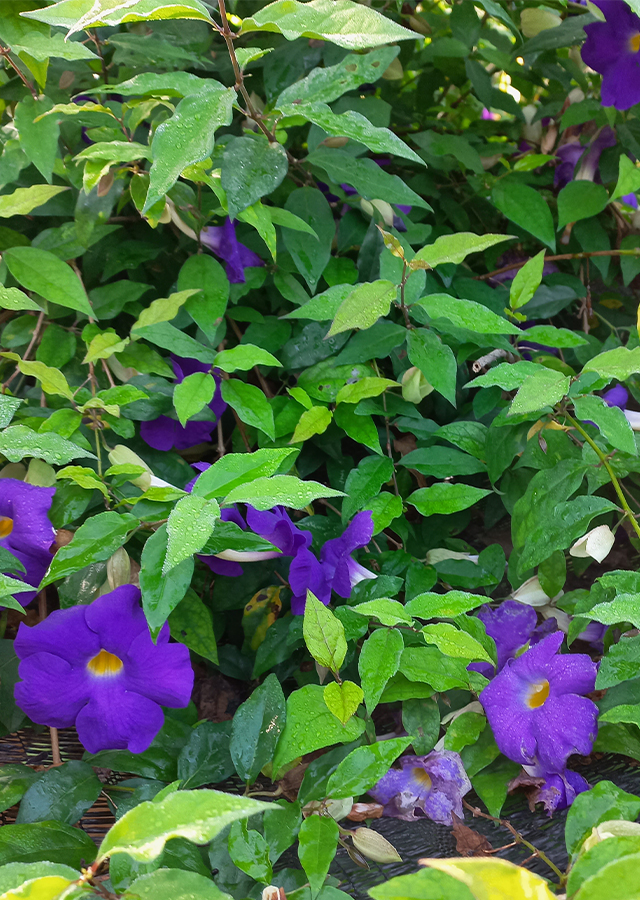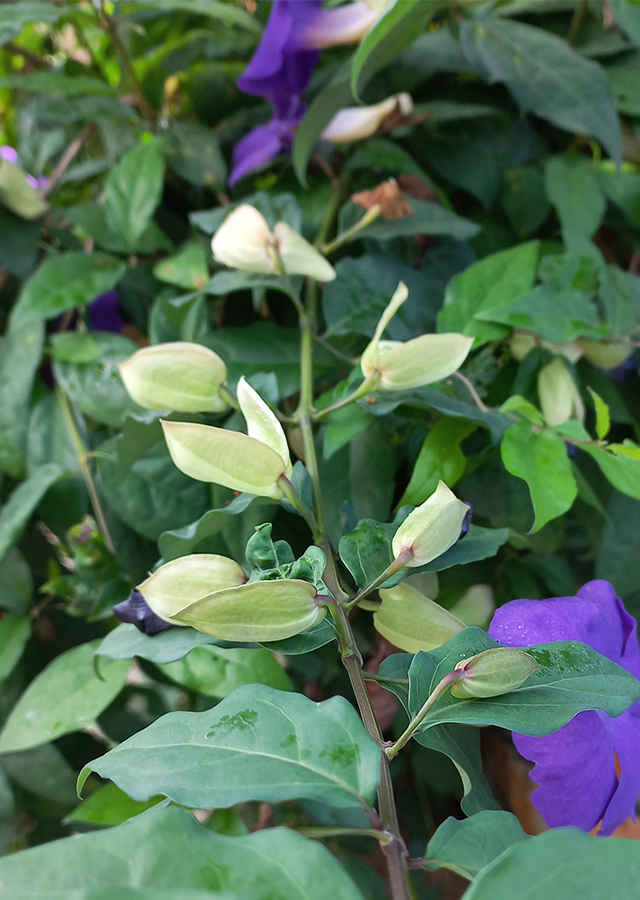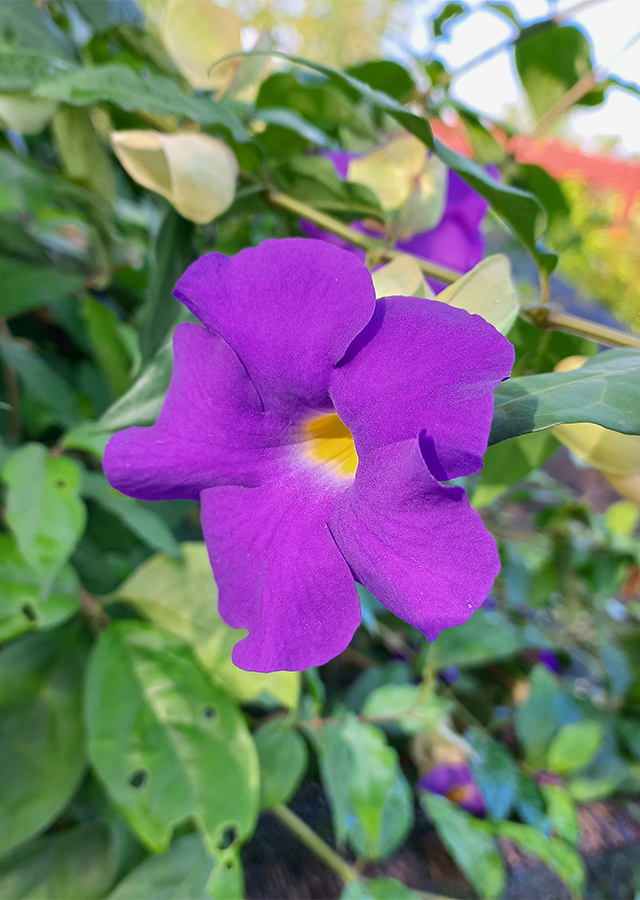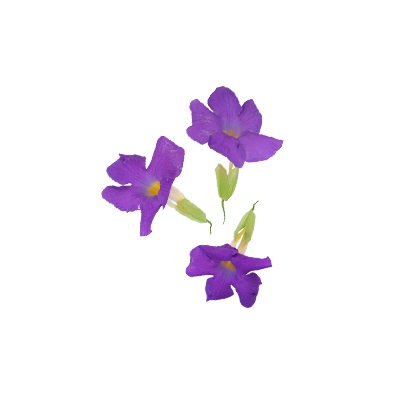Bush Clockvine
Thunbergia erecta (Benth.) T.Anderson
Acanthaceae
Location in our garden
Principal



Synonym
Meyenia erecta Benth.
Thunbergia ikbaliana De Wild.
Thunbergia mestdaghi De Wild.
Habitus
Shrubs. Perennial shrub growing around 3 metres tall
Part Used
Leaves
Flowers
Stem
Growing Requirements
Full Sunshine
Need Shade
Drought Resistant
Habitat
Forest
Roadside
Shrublands
Terrestrial
Overview
Thunbergia erecta is a native of tropical West Africa, but it has been introduced and can be found cultivated and naturalized in tropical Asia, North, Central and South America and the Caribbean. Thunbergia erecta is a garden ornamental that has repeatedly escaped cultivation and is naturalized across many tropical regions. Thunbergia erecta is the most abundant medicinal plant in various parts of Bangladesh where it is known as "nilghonta". It has been used as a folk remedy for insomnia, depression and anxiety.
Vernacular Names
King's mantle, Purple bush clockvine (English), Conchita, Maena, Mainereta, Mainereta blanca, Matrimonio chino, Meyenia, Vellosilla (Cuba), Campanita india, Corona de nazareno, Trompeta de ángeles (Dominican Republic), Queue de loup (Lesser Antilles), Kwa-nyo (Myanmar), Angelina, Boca de vieja, Violeta, Viuda (Puerto Rico).
Agroecology
Thunbergia erecta is a garden ornamental that has escaped cultivation and can be found naturalized along roadsides and trails, in disturbed sites, abandoned gardens near human settlements, thickets and forest edges, at elevations ranging from near sea level to approximately 1000 m. Thunbergia erecta prefers to grow in moist to dry areas with full sunlight or partial shade. It is adapted to a wide range of soil types, including acidic and alkaline sandy, loam and clay soils.
Morphology
- The stem - internodes between leaf-bearing nodes 2.5-6.5 cm long, 1.25-2.5 mm thick, quadrangular, glabrous.
- Leaves - with glabrous petioles to ca. 5 mm long; laminae elliptic, 1.5-6.5 (8.5) cm long, 0.8-2.6 (4.3) cm broad, apically acute, basally acute, margins undulate, glabrous to subglabrous on both surfaces.
- Flowers - solitary in leaf axils, peduncles to 2.8 cm long, glabrous; bracts oblong-ovate, 10-20 mm long, 5-8 mm broad, apically acute, basally obtuse, glabrous to minutely puberulous at the apex. Flowers with the calyx reduced to 10-16 subulate teeth ca. 3 mm long, glandular-puberulous; corolla all white or deep violet lobes with a yellowish throat, broadly salverform, glabrous, 6-8 cm long, 6-8 mm broad basally constricting to 2-3 mm broad just above the ovary, expanding to 15-20 mm broad at the throat, lobes suborbicular, 15-25 mm in diameter; cells of the anther unequal, the base and margins of the anther cells puberulous.
Cultivation
Thunbergia erecta is able to spread by seeds and vegetatively by stem fragments.
Chemical Constituents
β -Sitosterol-3-O- β - D-glucoside, apigenin, apigenin-7-O- β - D-glucoside, 3-Methoxy-4-hydroxy benzoic acid (vanillic acid), trans-ferulic acid, 3,4,5-trimethoxyphenol-1-O-β-D-glucoside, acacetin-7-O- β- D-glucoside, acacetin 7-O-( α-D-apio-furanosyl) (1→6)-β-D-glucoside, benzyl-7-O- β-xylopyranosyl (1′′→ 2′ )-β-D-glucoside, rosmarinic acid.
Traditional Medicinal Uses
- Treats insomnia, depression and anxiety.
- Recommended as an Alzheimer's drug and as an antidiabetic agent.
- In the area of origin, the plant is used as a herbal medicine in children to treat intestinal worms and wound care.
- In Myanmar, the leaves are used to treat bile disorders.
- In India it is used as an ingredient in poultice for headaches.
Part Used
Reference Sources
- CAB International. 2021. Thunbergia erecta (bush clockvine). https://www.cabi.org/isc/datasheet/34314768. 14-2-2022.
- Mohamed S. Refaey, Reda A. Abdelhamid, Hanan Elimam, Yaseen A.M.M. Elshaier, A. A. Ali, Mohamed A.A. Orabi. 2021. Bioactive constituents from Thunbergia erecta as potential anticholinesteraseand anti-ageing agents: Experimental and in silicostudies. Jurnal Bioorganic Chemistry 108 (2021) 104643. https://www.academia.edu/45567885/Bioactive_constituents_from_Thunbergia_erecta_as_potential_anticholinesterase. 14-1-2022.
- Flora Fauna Web. 2020. Thunbergia erecta. https://www.nparks.gov.sg/florafaunaweb/flora/2/5/2509. 14-1-2022.
- Anawara Begum, Abul Hossen, Ayasha Akter Moly, Md. Mahbubur Rahman Bhuiyan, Md. Shahed-Al-Mahmud. 2019. In Vivo Sedative and Anxiolytic Activities of Thunbergia erecta (Acanthaceae) Leaves Activate Gamma-Aminobutyric Acid (GABA) Mediated Hyperpolarization in Swiss Albino Mice. Pharmacology & Pharmacy, 10, 177-193. https://file.scirp.org/pdf/PP_2019041716131167.pdf. 14-1-2022.



